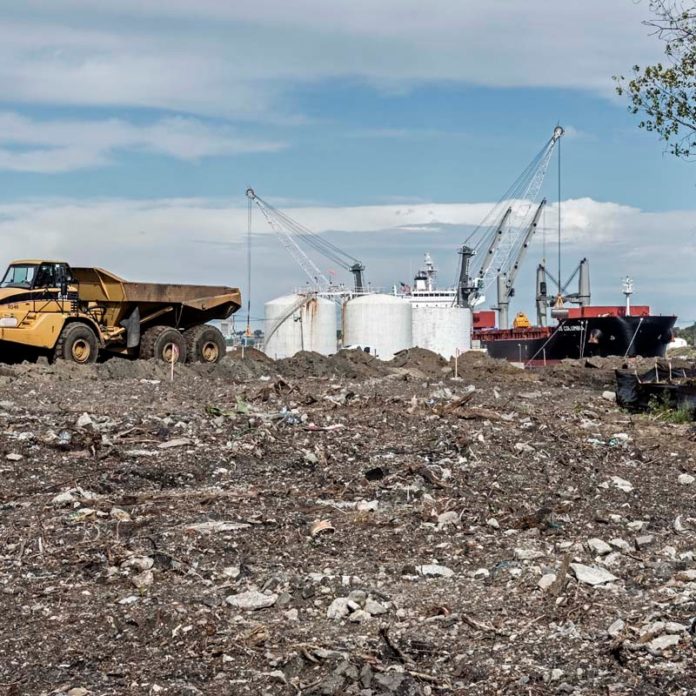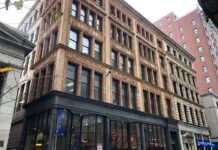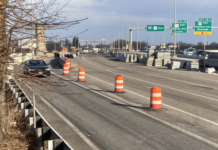
Activity on the industrial waterfront of Providence, including its deepwater port, is measured in tons and vessel calls, and the economic impact of its imports and exports.
Nearly 200 ships slide up to Providence berths each year, making the marine-industrial district the third largest for vessel calls in New England, according to the U.S. Department of Transportation. The Port of Providence, which is managed by the nonprofit ProvPort Inc., is the 105-acre heart of the city’s commercial waterfront. It is responsible for 2 million tons and at least 100 vessel calls annually, according to a spokesman.
An economic-impact report released by ProvPort earlier this year indicates the port supports 5,000 full- and part-time workers, and set its economic output at $164 million for the city and $211 million for Rhode Island.
It’s a big business by any of these measures.
But like the city it represents, the Port of Providence is seen by advocates as having the potential to become something more significant than it is today.
Providence Mayor Jorge O. Elorza, who made increasing port activity a platform in his 2014 campaign, calls it an overlooked asset.
“It is so underutilized,” Elorza said in a recent interview. “It’s as if we built the highway, the new [Route] 195 highway, and then used it as nothing more than a bike lane.”
There are proposals that would increase the port’s output, including a liquefaction facility at a National Grid liquid natural gas site and a cement-distribution facility at an unidentified site. Environmental advocates, however, remain wary of the pollution fallout in densely packed neighborhoods abutting the port, should it see significant expansion.
“That’s where all the toxins and hazardous energies are concentrated,” said Environmental Justice League of Rhode Island Youth Leadership Director Jesus Holguin of the port area and nearby highway. “And it is situated in a community of mostly lower class, black and brown, Latino and Hispanic folk.”
City Council President Luis A. Aponte, however, says he’s heard few complaints from any of the actual residents of those neighborhoods.
“That port was designated a long time ago to be the center of heavy industrial uses,” Aponte said.
LOW PROFILE
One impediment to expanding port activity is that there is little available land within ProvPort. Another is that much of the world is unaware of what the port offers, Elorza says.
The city is now conducting a study to determine whether it would be feasible to extend the ProvPort footprint. A swath of waterfront from the Hurricane Barrier to the ProvPort boundary is under review, the mayor said.
All of the land is privately held. The ongoing study, Elorza said, will determine whether it is feasible for the city to expand the public holdings.
The port has the potential to reap benefits for the city in taxes and employment. In New England, only Boston has a port with a similar depth, according to the mayor.
When he ran for mayor, Elorza said he wanted to double the city’s export economy, including through the Port of Providence, in five years.
“ProvPort is full right now,” Elorza said. “But there is actually a lot of undeveloped land on the waterfront.”
That land has been fallow despite adoption of land-use and tax-incentive plans that were intended to encourage more intensive development of cleared properties along the waterfront.
The area south of Thurbers Avenue since 2010 has had a redevelopment plan attached to it that was intended to spark development.
At ProvPort, the city’s redevelopment plan identified priorities for new infrastructure, including a looped rail system that would allow longer trains to access the berths.
Some improvements have come recently with federal assistance, including two electric harbor cranes that allow stevedores to unload ships more efficiently. The cranes, which began operating in 2013, replaced 30-year-old, rented cranes that were considered obsolete. The $21 million investment came through a $10.5 million federal grant, as well as matching funds from ProvPort, the nonprofit corporation that manages the port.
In a statement, ProvPort spokesman Bill Fischer said the port managers have a good working relationship with Elorza, and are working with him to encourage growth.
“He is right to emphasize the importance of the port as an economic driver for both Providence and the state,” Fischer said. “We certainly believe there are opportunities for growth and are working with him to ensure ProvPort continues to have opportunities to expand.”
In addition to infrastructure priorities, the redevelopment plan, put in place in 2010, identified several parcels that could be redeveloped, or acquired to expand the port. The largest, a former city landfill, this past summer was transferred to ProvPort under a lease with the Providence Redevelopment Agency. The site, located between the existing port and the Save The Bay campus, will be graded, paved and used as a staging area for port tenants, including potentially for used automobiles heading to West Africa. In a statement, Fischer said the possibilities are still being considered.
Beyond the limited footprint of the port, Elorza said it has not been marketed effectively. Since becoming mayor in January, he has toured port facilities in Hong Kong and Charleston, S.C., and met with officials in Guatemala.
“What we hear constantly is we don’t have anyone marketing our port. You would think the market would just know Providence has an underutilized, deepwater port. But that’s not the case,” he said.
“You have to get out there and talk to folks, the exporters, and tell them we have an opportunity here in the city, and putting it in a way that’s digestible and attractive to them,” Elorza said.
City Councilman Terrence M. Hassett, whose committee reviewed the port-redevelopment plan, said expanding port activity is somewhat difficult because the site is landlocked by Johnson & Wales University to the south.
The commercial waterfront area is a strategic location for the city, Hassett said, but much of it is fallow. “It’s become dormant,” Hassett said. “We should be pushing seeds to all of the waterfront.”
TENANT GROWTH
ProvPort purchased the Port of Providence from the city for $16.5 million in 1994, and through its management company, Waterson Terminal Services, oversees the facility. Under a long-term arrangement, the city has the option to repurchase the site for $1 in 2036.
In January, marking its 20th anniversary, ProvPort described the financial impact the operation has on the city and state, setting its economic impact over the next five years at $2.3 billion, including 5,500 jobs.
The report also outlined plans for additional investment.
Seven of the eight companies that leased space at ProvPort as of January planned to make their own investments. The tenants planned to spend $33 million to $50 million by 2020, and hire about 100 more employees, according to the analysis.
Fischer would not disclose which tenants plan to expand. Tenants include EUKOR Car Carriers, based in Seoul, South Korea, which exports 1,500 used cars a month to destinations in West Africa. Others include UNIVAR USA, which manufactures chlorine and moves 50,000 tons annually, and Schnitzer Steel, which exports 570,000 tons of scrap metal for recycling annually.
Since January, two more tenants have joined ProvPort. They are Mid-American Salt, based in Fort Wayne, Ind., which ships road salt through the Providence port, and Ensio Resources, which ships copper slag.
When asked whether the port needs help marketing the site, or help with infrastructure needs, ProvPort, through Fischer, said state and city officials need to apply long-term, strategic thinking to the port from a development perspective.
“Many states, including Connecticut, are making significant capital investments in their port infrastructure. Long-term planning and investment will ensure that the Port of Providence can continue to compete in the marketplace,” Fischer said.
Mid-American Salt, which operates a salt mine in Morocco, began to ship road salt through the port in February, responding to a spike in demand from clients to clear winter roads. The company has a 45,000-ton vessel that takes the material directly from North Africa to Rhode Island. ProvPort’s two cranes can unload the hold efficiently, said Joshua Hunter, the company’s sales manager. Tractor-trailer and other trucks then access the port and deliver the salt to clients in Connecticut, Massachusetts and Rhode Island. When a shipment arrives, hundreds of trucks a day distribute the material, Hunter said.
The company chose Providence because it’s in a good geographic location that could support its vessels. Mid-American Salt has already invested $100,000 in a commercial scale on its leased site, he said, to reduce any backups among trucks waiting to leave. The company is the largest importer of road salt through the Midwest, he said, and is looking to expand its reach.
“It’s a good geographic point to distribute to the Northeast,” Hunter said.
FUTURE PROJECTS?
In addition to the new tenants who emerged this year, several proposed developments have the potential to add more investment in the waterfront area.
They include the proposed liquefaction facility at the National Grid liquid natural gas site. The project, which could cost $100 million depending on its final design, would allow the utility to convert natural gas that is piped to the site to a liquefied form, enabling it to store a reserve in its existing tank that would not be derived from overseas sources, primarily from Trinidad and the Middle East.
The liquid natural gas stored in the tank is now trucked in daily, primarily from a site in Everett, Mass., north of Boston, according to David Graves, a National Grid spokesman.
The existing tank, which holds 23 million gallons, can be filled with 2,300 trucks, he said. The liquefaction facility would be built on the National Grid site on Terminal Road, using the existing underground pipe network.
It requires federal approval, because it would allow National Grid to then transport the liquid natural gas produced on-site to points in Massachusetts.
There is no plan to ship the natural gas overseas, or through the port, according to Graves. “You would have to close down an area around that vessel. It would basically shut down any water traffic in Narragansett Bay.”
In addition to the National Grid project, a Canadian manufacturer of cement has plans to build a distribution facility on an as-yet unidentified site at ProvPort. The plans were disclosed publicly when a request for property and tangible property tax incentives was made to the City Council.
McInnis Cement, based in Montreal, through an affiliated company wants a facility at the port that would act as its regional transfer center for cement throughout the Northeast. The manufacturing plant is now under construction at Port-Daniel-Gascons, in the province of Quebec.
The company will reveal more information about the facility, including renderings, once the council’s Finance Committee schedules a hearing on the tax-stabilization agreement request, according to a McInnis spokeswoman.
Aponte, who had been briefed on the proposal, said he understood the facility would be in the range of $40 million.
The new developments proposed at the port, and the surrounding commercial area off Allens Avenue, is appropriate for the location, according to several city officials, who say the area has the potential to support more intensive development that would help shore up the city’s tax base and create new jobs.
Environmental-based opposition to the National Grid project has emerged over the past several months.
Aponte, who represents Lower South Providence and Washington Park, said most of the opposition he’s heard has come from organized environmental groups, rather than people who live in the neighborhoods.The liquid natural gas that is now trucked in daily, he said, would be replaced with gas that arrives at the site through existing pipes. “As opposed to having 20 trucks a day,” he said.
Hassett agreed that the area could support additional development.
“What has happened is it’s been absent from fervent discussions for a while,” he said. “We need to take a hard look at what we have as an asset. Our obligation is to make the best, full use of that asset.”
The nonprofit Environmental Justice League of Rhode Island is concerned that neighborhoods that include lower South Providence and Washington Park are bearing the brunt of development that impacts residents’ health, according to Steve Roberts, its organizing director.
The lower South Providence and Washington Park neighborhoods are identified by the R.I. Department of Health as a Health Equity Zone, because they feature elevated rates of asthma, high rates of obesity, illness, chronic disease and other adverse health outcomes, he said.
The commercial operations near and at the port are contributing to the environmental risks, he said, as are Interstate 95 and other features of the neighborhood.
The primary focus of environmental activism is the National Grid proposal. At a hearing recently on the Fields Point Liquefaction Project, held by the U.S. Federal Energy Regulatory Commission, the commission representatives pointed out that the utility company has been storing liquid natural gas on the site for 40 years.
The speakers were uniformly opposed to the facility. Holguin, who grew up in the area, and who attended high school in lower South Providence, said he and three of his siblings have asthma. He attributes it to the environmental factors.
The idea that Allens Avenue, or even the highway, acts as a barrier to the residential neighborhood is nonsensical, he said.
“Toxins don’t say, ‘Oh look, this is a house. I won’t go there,’ ” he said.
Elorza, while championing the potential of the port as an economic driver for the city, said he expects companies to be good environmental stewards. Some over time have not been, he said.
He is continuing to evaluate the National Grid project, he added.
“If you look at ports throughout the country, it used to be the case that if you have an industrial port, there is a great deal of pollution that goes along with it. That’s not the case with it anymore. You can have environmentally sustainable ports. I want to make sure we unlock its productive value.” n
Current tenants at ProvPort
n EUKOR Car Carriers – used autos, 1,500 vehicles exported a month to West Africa.
n UNIVAR USA – chlorine manufacturer and wastewater treatment services, 50,000 tons moved annually.
n Enterprise Products – liquefied petroleum gas, 180,000 tons moved annually.
n Lehigh Northeast Cement – bulk cement, 50,000 ton dome, 180,000 tons moved annually.
n Schnitzer Steel – scrap steel, 570,000 tons exported annually.
n Washington Mills – aluminum oxide, 80,000 tons moved annually.
n New England Petroleum – heating oil, 55.8 million gallons moved annually, 16.5 million tank farm.
n Morton Salt – road salt, 300,000 tons moved annually.
n Mid-American Salt – road salt, tons not disclosed.
n Ensio Resources – copper slag, tons not disclosed.
Source: ProvPort Economic Impact statement January 2015 and PBN reporting












